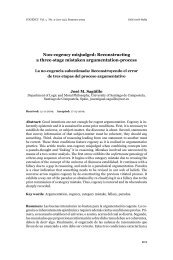Cogency v2 n2
Cogency v2 n2
Cogency v2 n2
You also want an ePaper? Increase the reach of your titles
YUMPU automatically turns print PDFs into web optimized ePapers that Google loves.
COGENCY Vol. 2, N0. 2, Spring 2010<br />
language, in treating this circumstance as though some “rational resolution”<br />
were available, Feldman’s presentation assumes that the evidentiary<br />
relations which determine where the stone eventually lands already exist–<br />
as though there was already some “proper” measure for their evaluation<br />
which determines the “rational response” to the question of the stone’s final<br />
placement. (For Feldman (p. 16; emphasis added) rational resolution follows<br />
the “proper evaluation” of arguments and evidence, and is available<br />
when “there is some way of presenting arguments and evidence to which<br />
the rational response is a resolution of the disagreement.”) Yet, given the<br />
nature of the situation – one in which the language-game(s) in play do not<br />
specify a resolution to the issue – such evidentiary relations do not yet exist;<br />
and they do not yet exist because we have not determined them. We have<br />
not stipulated the use of the concept (in this circumstance).<br />
Further, Feldman’s (p. 19) ‘expansion’ of the concept of evidence to include<br />
the sorts of activities and practices that at one time held the stone in<br />
place obscures and misconstrues the relationship of those activities to the<br />
concept. They do not provide reasons or evidence for the application of a<br />
concept in one way rather than another. Rather they provide the very semantic<br />
content of the concept by stipulating the norms of its application.<br />
Thus, Fogelin is quite right to say that such practices precede reasons and<br />
instead provide the very conceptual context in which reason-giving occurs.<br />
Finally, Feldman’s construal of the situation ignores the fact that it will not<br />
have been merely one stone that is loosed into the stream. Such a stone was<br />
embedded in a way of doing (thinking and acting) (OC § 144). Once loosed,<br />
all the connected ways of doing will similarly be affected by the stone’s displacement.<br />
Thus, what is at issue is not merely the acceptability of some<br />
claim but an entire way of doing.<br />
Lugg attempts to supplement the supply of rational resources available<br />
to deep disagreers in such a way that the reach of their reasonings is not<br />
limited by their initial agreements. Yet, in a mistake similar to Feldman’s<br />
(above), Lugg seems to misconstrue the nature of those agreements that<br />
prescribe the reach of our reasoning. As Wittgenstein tells us, “It is not agreement<br />
in opinions but in form of life” (PI § 241). Thus, while the results of<br />
argumentation (whether deep or normal) are not limited or determined by<br />
54








